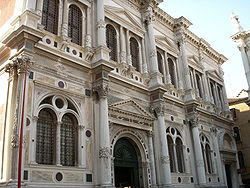
Scuola Grande di San Rocco
Encyclopedia

Venice
Venice is a city in northern Italy which is renowned for the beauty of its setting, its architecture and its artworks. It is the capital of the Veneto region...
, northern Italy
Italy
Italy , officially the Italian Republic languages]] under the European Charter for Regional or Minority Languages. In each of these, Italy's official name is as follows:;;;;;;;;), is a unitary parliamentary republic in South-Central Europe. To the north it borders France, Switzerland, Austria and...
.
History
The Scuola di San Rocco ("Confraternity of St. Roch", protector against plague, which had struck Venice in that century) was established in 1478 by a group of wealthy Venetian citizens, next to the church of San Rocco, from which it takes its name.In January 1515 the project of the building was entrusted to Bartolomeo Bon, although some authorities assign it to his son Pietro Bon. In 1524 his work was continued by Sante Lombardo
Sante Lombardo
Sante Lombardo was an Italian architect.-Biography:He was born in Venice, the son of Tullio Lombardo. It is mentioned for the first time in sources in 1534, when he was appointed protomastro of the Scuola Grande di San Rocco in Venice , for which he provided the internal and external decoration.In...
, who, in turn, three years later was replaced by Antonio Scarpagnino. Following his death in 1549, the last architect to work on the edifice was Giangiacomo dei Grigi, finishing in September 1560.
The design was similar to other scuole in Venice, characterized by two halls, one at ground floor level, the other at first floor level. The Sala Terra (lower) has a nave and two aisles, with the entrance from the campo outside. From this hall a stair (with a landing surmounted by a dome) led to the upper storey. The Sala Superiore ("Upper Hall") was used for meetings of the fellows and had a wooden altar. It provided access to the Sala dell'Albergo, which housed the Banca and the Zonta (the confraternity's supervisory boards).
Art
In 1564 the painter TintorettoTintoretto
Tintoretto , real name Jacopo Comin, was a Venetian painter and a notable exponent of the Renaissance school. For his phenomenal energy in painting he was termed Il Furioso...
was commissioned to provide paintings for the Scuola, and his most renowned works are to be found in the Sala dell'Albergo and the Sala Superiore. All the works in the building are by him, or his assistants, including his son Domenico
Domenico Tintoretto
Domenico Robusti, also known as Domenico Tintoretto, was an Italian painter from Venetian. He grew up under the tutelage of his father, the renowned painter Jacopo Tintoretto.- Apprenticeship :Tintoretto was born at Venice....
: they were executed between 1564 and 1587. Works in the sala terra are in homage to the Virgin Mary, and concentrate on episodes from her life. In the sala superiore, works on the ceiling are from the Old Testament
Old Testament
The Old Testament, of which Christians hold different views, is a Christian term for the religious writings of ancient Israel held sacred and inspired by Christians which overlaps with the 24-book canon of the Masoretic Text of Judaism...
, and on the walls from the New Testament
New Testament
The New Testament is the second major division of the Christian biblical canon, the first such division being the much longer Old Testament....
. Together, they show the biblical story from Fall
Adam and Eve
Adam and Eve were, according to the Genesis creation narratives, the first human couple to inhabit Earth, created by YHWH, the God of the ancient Hebrews...
to Redemption
Redeemer (Christianity)
In Christian theology, Jesus is sometimes referred to as a Redeemer. This refers to the salvation he is believed to have accomplished, and is based on the metaphor of redemption, or "buying back". Although the New Testament does not use the title "Redeemer", the word "redemption" is used in several...
.
Main works include:
- Sala Terrena (complete list)
- Annunciation
- Adoration of the Magi
- The Flight into Egypt
- The Slaughter of the Innocents
- Presentation in the Temple
- The Assumption of Mary
- St Mary Magdalen
- St Mary of Egypt
- Sala Superiore (ceiling)
- Adam and Eve
- Jacob's Ladder
- God Appears to Moses
- The Passover
- The Pillar of Fire
- The Fall of Manna in the Desert
- Moses Strikes Water from the Rock
- Miracle of the Bronze Serpent
- Elijah is Fed by the Angels
- Elisha Distributes Bread
- The Vision of the Prophet Ezekiel
- Sala Superiore (walls)
- The Adoration of the Shepherds
- The Baptism
- Christ Tempted by Satan
- Christ Heals the Paralytic
- Multiplication of Bread and Fishes
- The Resurrection of Lazarus
- The Last Supper
- The Agony in the Garden
- The Resurrection
- The Ascension
- Wooden: episodes of the Old Testament by Giuseppe Angeli
- Sala dell'Albergo
- Allegory of St. John's Guild
- Allegory of St. Mark's Guild
- Allegory of St. Theodore's Guild
- Allegory of the Charity Guild
- Allegory of the Misericordia (Mercy) Guild
- Christ Before Pilate
- Ecce Homo (The Crowning with Thorns)
- Ascent to Calvary
- The Crucifixion
Other works present include paintings by Titian
Titian
Tiziano Vecelli or Tiziano Vecellio Tiziano Vecelli or Tiziano Vecellio Tiziano Vecelli or Tiziano Vecellio (c. 1488/1490 – 27 August 1576 better known as Titian was an Italian painter, the most important member of the 16th-century Venetian school. He was born in Pieve di Cadore, near...
and Palma the Younger.

